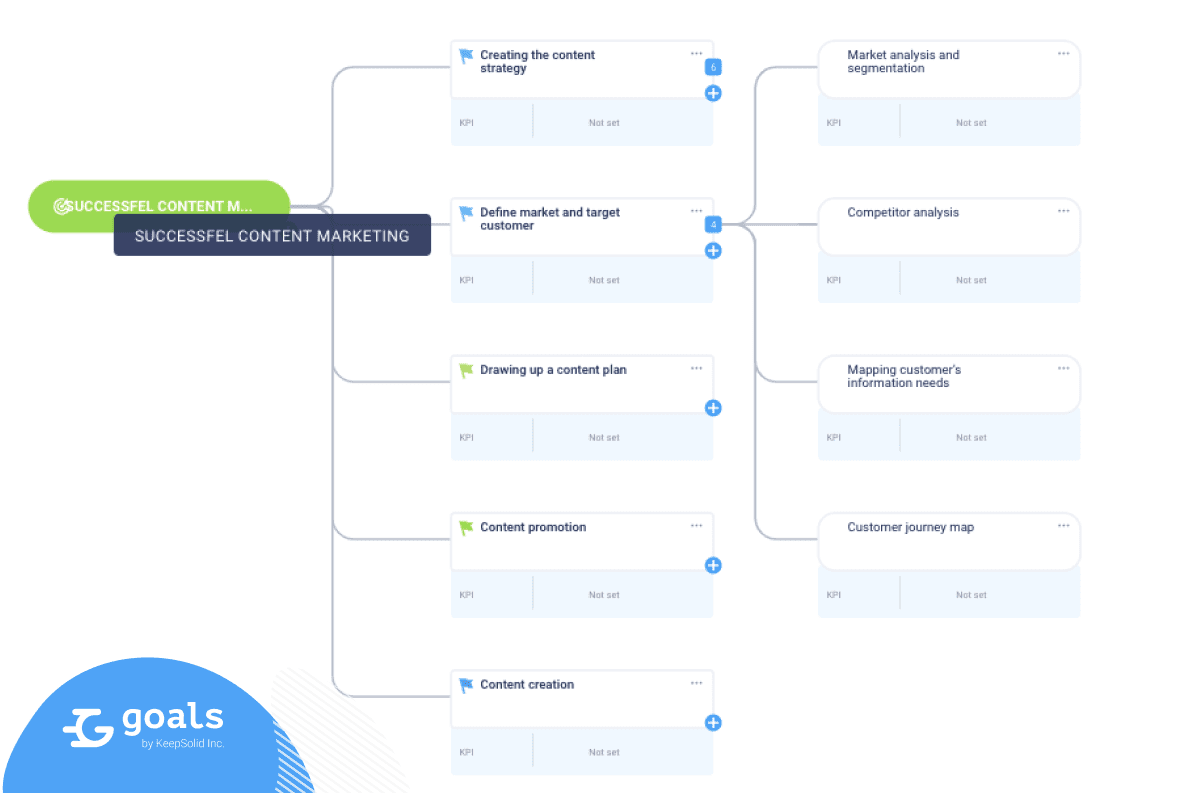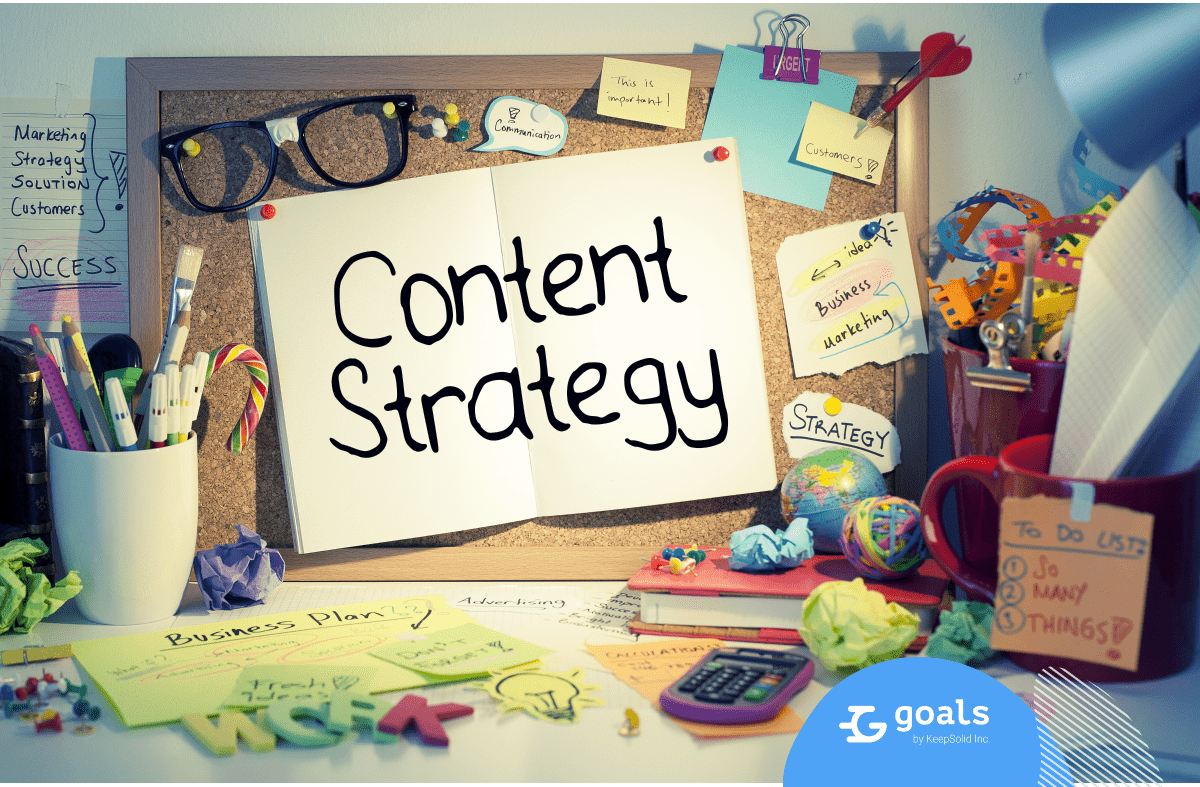The world has already changed. The consumer is spoiled by advertising. We have to accept that customers are not looking for a company that will sell something to them, but a solution to specific problems facing them now. At the same time, every business (and especially a startup) needs a constant flow of leads to generate more sales and grow their development. One of the best ways to generate high-quality leads is through content marketing. Content marketing costs 62% less and generates three times as many leads as traditional marketing. So, what are Goals by KeepSolid team’s specific tips on how to organize content marketing? What are the best solutions we have found?
1. Define your market and your target customer.
It is the crucial part of your content marketing strategy, if you miss it, you run the risk of quickly draining the budget and burning out.
- Make market analysis and segmentation. Here you have to define who is the target audience. Describe the audience separately because they all have different tasks, objections, selection criteria.
- Make the competitor analysis. Try to understand how others work: what channels are used to attract buyers; personalize the offer or sell it to everyone equally; what marketing tools are used (mailings, chatbots, etc.).
- Mapping information needs. Each stage of readiness for a deal is characterized by a set of questions asked by your potential client. Your customer looks for answers to them on the Internet, from friends, and in other sources that he considers reliable. Your task is to bring these issues into one document and draw up an information need map, which will later develop a content plan.
- Drafting the customer journey map. To finish your preparing you need to scatch out a map (or timeline) that lays out every customer experience stage. These stages are customer touchpoints – basically any time a customer comes in contact with your brand.
Along the way, customers will interact with your various touchpoints, such as an ad or your website. Once you’re in the customer mindset, you can map out your touchpoints, which likely include: social media reviews, your website, your customer service team, etc. By describing the customer journey map, you will get a perfect opportunity for what content is needed for each stage and each touchpoint.
2. Creating the content strategy
Content strategy is a route from point A, where the company is now, to point B, where you want to come over time, and a description of the tools that will help you go this way. Starting to write without having a content strategy is like going into unfamiliar territory without a map. Maybe you will, but the risk of getting lost is high. The content strategy may include the following points:
- Define global goals. What do I want to achieve with content marketing?
- Set targets for the year in numbers: website traffic, number of subscribers, leads, etc.
- Choose the types of content you plan to use: text, videos, podcasts, infographics, presentations, photos, webinars, etc.
- Choose content formats: tutorials/videos, case studies, walkthroughs, podcasts, checklists, etc.
- Define the frequency of publications on the site and guest resources (per month) in social networks (per day): how many units of the content of each format you will release.
- Select content distribution channels: blog, newsletter, social media profiles, targeted resources for guest publications (sites, forums, and communities where your target audience is).
3. Drawing up a content plan
We select topics from the information needs card and put them in a table.
- Planned content. For each material, I enter the following information: format, working title, site for placement, goal - what I want to achieve with this material; key queries)
- Content calendar.
- Ready-made lead magnets (from here, they can be pulled into the content calendar).
- Team building
- Budgeting
The money will be needed not only to create content (pay for the services of specialists) and promote it. A high-quality text is 20% of success. The remaining 80% is its competent distribution: the text should catch the eye of your potential client at the right time (remember the stages of readiness for a deal) and in the right place (on the site where it happens and where trusts). At the start, the money will be distributed between these two tasks, approximately 50/50. The promotion costs will begin to decrease due to developing their communities, increasing the company's awareness, growing a loyal audience, and establishing partnerships.
4. Content creation
What you create should reveal the issue in more detail, provide some new tools for solving problems, demonstrate a radically opposite popular opinion, etc., that is, differ for the better from everything that already exists on this topic in networks. The text should be useful - to answer readers' questions. The time people spend on the page, the readability of the material (how many % read it from beginning to end), the percentage of refusals (what % leaves the site from the article page) - all this affects the position of the site in the search results (and therefore the number of visitors).
5. Content promotion
Writing an article or shooting a video is the first step, then you need to make sure that representatives see the target audience’s content to whom it is addressed. In this time of unstoppable information flow, the distribution is as important as never before. If an article has been optimized adequately for relevant queries (you can find them using the free Google Keyword Planner service), users will find it themselves. Once you invest money and time in quality material, you can get visitors for years without spending a penny on it. What are other appropriate channels for distribution? Social networks, contextual advertising, Email marketing (it still works!).

The content marketing plan is one of the key elements in the strategy of any company. Lack of planning often makes marketing investments ineffective and unprofitable. Regularly working on the plan allows the company to invest in the most effective marketing channels. Setting the marketing plan in Goals by KeepSolid app will allow you to plan the sales volume correctly, divide it by channel, set objectives, and distribute the budget.



